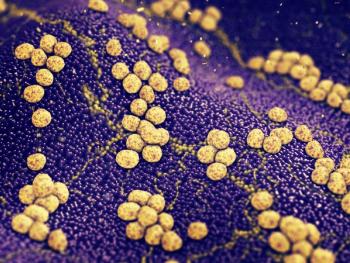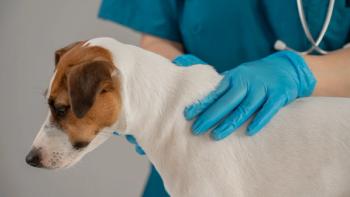
Neoplastic skin disorders (Proceedings)
Some of the most common canine cutaneous tumors include: histiocytoma, mast cell tumor, and the adnexal tumors. Cutaneous T-cell lymphoma (mycosis fungoides) is a pruritic neoplasia of older dogs with a poor prognosis.
Some of the most common canine cutaneous tumors include: histiocytoma, mast cell tumor, and the adnexal tumors. Cutaneous T-cell lymphoma (mycosis fungoides) is a pruritic neoplasia of older dogs with a poor prognosis. Recent literature supports a novel therapeutic agent for this terrible disease to improve clinical remission and quality of life. The focus of this presentation is to review common canine dermatologic neoplastic diseases, comment on diagnostic procedures and evaluate treatment options. The intent is to review those diseases that private practitioners should be comfortable treating and to assess when a case might be better in the hands of a competent veterinary oncologist.
A mass is a mass. The three primary differential diagnoses for a skin mass are: tumor (neoplasia), granuloma (infectious and non-infectious) and cyst (thank you Dr. Michael Willard for this important concept). Nobody can tell for sure what is going on without aspiration cytology and biopsy with histopathology and culture. Histopathology is considered to be the gold-standard. However, in the hands of a skilled clinical pathologist, a tentative diagnosis may be reached. Biopsy for macerated tissue culture is also an important yet commonly overlooked procedure.
Direct impression cell cytology evaluation should be performed on all skin masses with an erosive or ulcerative surface. A clean glass slide should be pressed against the skin surface and allowed to air dry. The author believes that heat-fixation is an important process but some clinical pathologists will disagree. Nonetheless, direct impression skin samples should be prepared in triplicate. One slide should be prepared for modified Wright's stain (Diff-quik ®) for the clinician to evaluate. One slide should be saved for Gram Stain evaluation if rod or cocci bacteria are seen on evaluation or if the lesion is severely exudative or hemorrhagic. A Gram stain is beneficial in helping to "wash-out" the background cellular structures to better evaluate the infectious organisms. Most rod shaped bacteria are Gram negative but a Diff-quik stain will not confirm this information. The third and final sample should be reserved for laboratory submission. Slides are cheap. It is better to take too many samples than not enough.
For all skin masses, aspirate cytology should be performed. The term aspirate implies that negative pressure will be applied to help exfoliate the skin mass and achieve a better diagnostic sample. Aspiration samples are best for sarcomas where exfoliation is difficult to achieve. For most skin samples, a needle core sample or "woodpecker technique" is recommended. Samples larger than 1 cm. should be collected with a 20 gauge needle. Smaller samples should be collected with smaller needles. The term "fine-needle aspiration" implies that a 25 gauge needle be employed. It is the author's experience that acquiring diagnostic samples with anything less than a 23 gauge needle is futile. The "woodpecker technique" is performed by stabilizing the mass and inserting the needle into the mass. For small skin masses, the needle can be inserted all the way through the mass if it is elevated above the skin surface. For larger masses, the needle should be inserted and withdrawn almost all the way out and then the angle should be changed for the next insertion. The idea is to collect a core sample of cells. Overzealous or unlucky sample technique can result in excessive hemorrhagic contamination. All samples should be evaluated regardless of the amount of hemorrhage. Once collected the needle should be attached to a syringe of at least 6cc size. A syringe of 12 cc will supply a greater pressure to remove exfoliated cells from the needle than a smaller needle. The needle should be aimed at a cleaned (yes, clean your slides with alcohol before sample technique) slide along the long axis of the slide. Slides should be prepared as described above.
Stained slides should be evaluated at 10X magnification. The key things to evaluate are the presence or absence of cells from the collection technique and to subjectively assess whether or not the sample appears to be more inflammatory or neoplastic. Inflammatory samples will be pleocellular with variable hemorrhage. Neoplastic cells may appear as a monocellular cluster or monomorphic sample in general. It is hard to define an inflammatory versus neoplastic process but important first impressions can be made at low power. Oil immersion 100X will help to identify infectious organisms such as bacteria or yeast. Intermediate assessment with 40X dry or immersion is helpful to assess subtle characteristics to distinguish and define a neoplastic process. Initial assessment for a novice cytologist should be able to accomplish 3 goals. First, are infectious organisms present? Secondly, is this a neoplastic process that should be followed with additional diagnostic procedures such as biopsy with histopathology or excision? Lastly, is this a quality sample that warrants a second opinion from a board-certified clinical pathologist? Poor samples should be repeated to prevent repeat visits from the client. You do not need to be an expert to make these simple assessments. Please charge accordingly for your time as each diagnostic step is one forward toward a diagnosis and prognosis.
The most common skin neoplastic diseases include those of the "round cell" type. The primary differential diagnoses include: mast cell tumor, lymphoma, and histiocytoma. Additional differential diagnoses include transmissible venereal tumor, plasma cell tumor, and Merkel's cell tumor (neuroendocrine tumors). Poorly differentiated tumors such as mast cell, lymphoma, plasma cell, and histiocytomas can be difficult to differentiate without histopathology and immunohistochemical staining.
Cutaneous histiocytoma is a benign tumor that often occurs as a single tumor in dogs less than 3 years of age. Regression may occur within 2 months of occurrence. Surgical excision is usually curative but may not be indicated. Reasons for surgical excision include uncertain diagnosis or that the patient is self-mutilating because of the lesion. Chemotherapy is rarely useful for solitary lesions. Antihistamines such as hydroxyzine may be useful to decrease pruritus whilst waiting for spontaneous regression. Other medications are usually not indicated. Reactive cutaneous histiocytosis includes multiple lesions. There is no breed predilection. Partial remission may be achieved with immune suppressive doses of corticosteroids but spontaneous remission may occur. Other immune suppressive agents may be indicated for refractive disease. Systemic hystiocytosis is a non-neoplastic disease that has been seen in Bernese Mountain dogs and others and will not be discussed here.
Cutaneous T-cell lymphoma (a.k.a. mycosis fungoides or epitheliotropic T-cell lymphoma) is a neoplastic process of generally older dogs. The clinical signs are variable. Initially, scaling and pruritus are seen. In many cases, the intensity of pruritus is severe and inappropriate for the age and onset of clinical symptoms. The skin may progress to thickened, exudative lesions that may resemble common clinical diseases such as pyoderma, demodex, and dermatophyte. Finally, plaques and skin masses with variable ulceration may be identified. Lymphadenopathy may be present or absent. Lesions may be completely confined to the skin. However, staging is still recommended. Staging includes: serum biochemistry, complete blood count, and urinalysis, histologic and cytologic evaluation of lymphnodes, histologic and cytologic evaluation of extranodal sites, bone marrow evaluation, and radiographic imaging. Cutaneous T-cell lymphoma carries a guarded to grave prognosis. Staging will help the client decide whether or not to pursue treatment. Immune suppressive agents are rarely useful in improving clinical signs or quality of life. The use of the agent CCNU (Lomustine) has resulted in clinical remission in some patients. Hepatotoxicity and bone marrow suppression are potential side effects. Clinical staging and patient monitoring are essential in deciding whether to pursue treatment.
Newsletter
From exam room tips to practice management insights, get trusted veterinary news delivered straight to your inbox—subscribe to dvm360.




